Home Tags Posts tagged with "lady thatcher"
lady thatcher
Former British PM Margaret Thatcher was this afternoon cremated at Mortlake Crematorium in South-West London.
After a reception for the guests at her ceremonial funeral, Margaret Thatcher’s body was driven from St Paul’s Cathedral to the suburban district.
Margaret Thatcher’s ashes are due to be interred next to those of her beloved husband Denis, who died in 2003, at the Royal Hospital Chelsea.
Following the spectacular funeral at St Paul’s, Queen Elizabeth II and the Duke of Edinburgh joined Lady Thatcher’s family to watch her coffin loaded into a hearse and taken to the Chelsea hospital in preparation for her final journey.

Former British PM Margaret Thatcher was this afternoon cremated at Mortlake Crematorium in South-West London
Relatives then moved on to a reception at the Guildhall to thank the funeral guests for their attendance.
After the reception ended, Margaret Thatcher’s coffin left Central London – roughly four hours after the conclusion of the funeral service.
The vehicle was accompanied by police motorcyclists en route to Mortlake Crematorium.
The convoy drove west through Central London, and crossed Putney Bridge on its way to the suburb in the Borough of Richmond.
Dozens of onlookers lined the street and applauded as the coffin entered through the crematorium gates, which were guarded by two police officers.
Another two police officers saluted as the hearse went into the grounds, followed by two Jaguar cars and a Range Rover.
Two coaches carrying guests had arrived at the crematorium half an hour earlier, for a private service before the cremation.
Margaret Thatcher’s ashes will eventually be buried with those of Sir Denis, under a marble slab in the grounds of the famous hospital.
Other well-known figures to have been cremated at Mortlake Crematorium include comedian Tommy Cooper, actor Michael Redgrave and political journalist Robin Day.
[youtube eaEqpNo-YkA]
The body of former British PM Margaret Thatcher is to be moved to a chapel in the Palace of Westminster later, ahead of Wednesday’s funeral.
A service, led by the Dean of Westminster, will be held in the Chapel of St Mary Undercroft.
MPs are also expected to vote later on whether to cancel Prime Minister’s Questions in order to allow them to attend the funeral.
Two MPs are trying to block the plan to delay the start of Commons’ business.
Respect MP George Galloway and Labour’s Dennis Skinner have both objected to the cancellation of PMQs, meaning MPs will now have to debate and vote on the plan before the change can be made.
If agreed, parliamentary business would not begin until 14:30 BST on Wednesday.
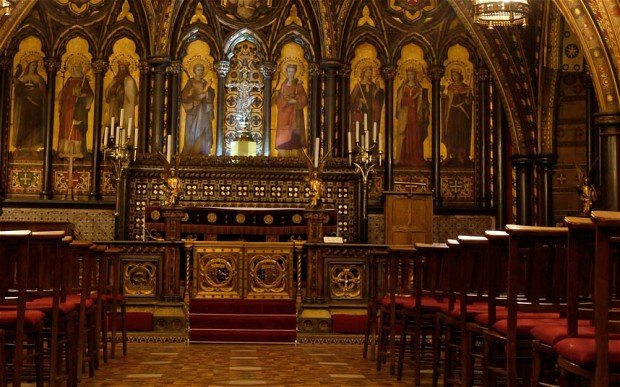
Margaret Thatcher’s body will be moved to the Chapel of St Mary Undercroft in the Palace of Westminster, ahead of Wednesday’s funeral
George Galloway says there has been “unnecessary fawning” over Margaret Thatcher, who was Conservative prime minister from 1979 to 1990.
However, the motion is expected to be passed after Labour said its MPs would not oppose it.
Margaret Thatcher, who died at the age of 87 on April 8 at the Ritz Hotel in London, has been accorded a ceremonial funeral with military honors, one step down from a state funeral.
The ceremonial funeral will take place at St Paul’s Cathedral, London.
Before the funeral, Margaret Thatcher’s body will rest overnight in the Chapel of St Mary Undercroft in the Palace of Westminster.
A short service, for around 100 people, will be led by the Dean of Westminster and attended by members of the family, senior figures from both Houses of Parliament and staff from Parliament and Downing Street who knew or worked closely with Lady Thatcher.
After the service, the chapel will be open for several hours in order that members of both Houses and parliamentary staff may pay their respects.
The Speaker’s chaplain, the Rev Rose Hudson-Wilkin, will then keep vigil in the chapel through the night.
On Wednesday, Margaret Thatcher’s coffin will initially travel by hearse from the Palace of Westminster to the Church of St Clement Danes – the Central Church of the RAF – on the Strand.
It will then be transferred to a gun carriage and taken in procession to St Paul’s Cathedral.
St Paul’s Cathedral has published a full funeral order of service for Margaret Thatcher.
Big Ben will be silent for the duration of Margaret Thatcher’s funeral, House of Commons Speaker John Bercow has announced.
John Bercow told MPs this would be “an appropriate means of indicating our sentiments” during the occasion.
There was a “profound dignity through silence,” he added.
The silence will last throughout events on Wednesday, covering the procession from Westminster and the ceremony at St Paul’s Cathedral.

Big Ben will be silent for the duration of Margaret Thatcher’s funeral
The chiming of Big Ben, the name often used to describe the Great Bell, the Great Clock and the Elizabeth Tower – clock tower – in the Palace of Westminster, is one of London’s most famous sounds.
Big Ben has not been silent as a mark of respect since the funeral of former PM Sir Winston Churchill in 1965, although it was out of action for repairs for a period during the 1970s.
In a statement to the Commons, John Bercow said he had received “direct and indirect representations” over the best way for Parliament to mark the funeral of Margaret Thatcher, who died last week aged 87.
John Bercow added: “I’ve considered all of these, but I concluded that the most appropriate means of indicating our sentiments would be for the chimes of Big Ben and the chimes of the Great Clock to be silenced for the duration of the funeral proceedings.”
He also said: “I believe there can be a profound dignity and deep respect expressed through silence.”
Responding for the government, Cabinet Office minister Francis Maude said it was a “very dignified and respectful gesture on behalf of Parliament”.
“As you know, Lady Thatcher held Parliament in very great reverence in her time both in this House and in the Lords,” he said.
“I am confident that Lady Thatcher’s family will take it very much in that spirit and be very appreciative of what you have decided.”
Margaret Thatcher has been accorded a ceremonial funeral with military honors, one step down from a state funeral.
A military rehearsal of the procession took place in central London during the early hours of Monday morning.
On Wednesday, Margaret Thatcher’s coffin will initially travel by hearse from the Palace of Westminster to the Church of St Clement Danes – the Central Church of the RAF – on the Strand.
The coffin will then be transferred to the gun carriage and taken in procession to St Paul’s Cathedral.
Big Ben Facts:
- The Great Bell, better known as Big Ben, is 2.2 m tall, has a diameter of 2.7 m and weighs 13.7 tonnes
- The hammer which strikes the bell weighs 200 kg
- When struck it chimes the musical note E
- It was cast in the Whitechapel Bell Foundry, and installed on 10 April, 1858. It took 18 hours to lift it into the clock tower’s belfry
- The chimes of Big Ben were first recorded and broadcast by BBC engineer AG Dryland on New Year’s Eve 1923
- It was out of action from 09:45 GMT until midnight on the day of Sir Winston Churchill’s funeral
A military rehearsal of former British PM Margaret Thatcher’s funeral procession has taken place in central London.
More than 700 members of the armed forces drawn from all three services took part in the practice before dawn.
They will line the route of the funeral procession from Westminster to St Paul’s Cathedral on Wednesday.
Margaret Thatcher’s coffin is to be carried in a gun carriage drawn by the King’s Troop Royal Horse Artillery, which was involved in the rehearsal.
Major Andrew Chatburn, the man in charge of choreographing the parade, said the rehearsal “went very well” and it was “vitally important” to stage a trial of Wednesday’s event.
“Timings are most important,” he said.
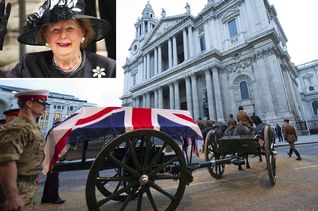
Military rehearsal of former PM Margaret Thatcher’s funeral procession in central London
Maj. Andrew Chatburn, ceremonial staff officer for the Household Division, who was also behind the royal wedding procession two years ago and last year’s Diamond Jubilee parade, added: “Bearing in mind these are sailors, soldiers and airmen who have come in to do this specific task from their routine duties, so it’s new to them.
“They need to see the ground as well so they can get a feel for how it’s going to go and they can perform their duties with confidence on the day.”
The procession band played the funeral marches of Chopin, Beethoven and Mendelssohn as it made its way along the deserted streets for the rehearsal.
The Chelsea Pensioners from Royal Hospital Chelsea did not take part due to the early start, but they will line the west steps of St Paul’s for the real event.
It has emerged that the last portrait of Margaret Thatcher shows her relaxing on a deckchair in the garden of London’s Royal Hospital Chelsea, a retirement and nursing home for ex-British soldiers. Lady Thatcher was a strong supporter of the Chelsea Pensioners.
Scotland Yard’s preparations are ongoing and the force says the security operation on the day will be in line with the perceived threat level.
Margaret Thatcher, who died at the age of 87 on April 8, has been awarded a ceremonial funeral with military honors, one step down from a state funeral.
On Wednesday, Margaret Thatcher’s coffin will initially travel by hearse from the Palace of Westminster to the Church of St Clement Danes – the Central Church of the RAF – on the Strand.
The coffin will then be transferred to the gun carriage and taken in procession to St Paul’s Cathedral.
St Paul’s Cathedral has published a full funeral order of service.
Respect MP George Galloway has said he will try to block plans designed to allow MPs to attend Margaret Thatcher’s funeral.
Ministers want to cancel Prime Minister’s Questions and delay the start of parliamentary business – an approach backed by Labour.
[youtube wE0LR6T43kk]
Margaret Thatcher’s funeral will not be attended by former Soviet leader Mikhail Gorbachev due to health problems, his spokesman has announced.
Mikhail Gorbachev, 82, with whom the former British prime minister worked closely at the end of the Cold War, was expected to be one of a number of global figures attending.
Downing Street said consultation over the funeral guest list was continuing.
It has confirmed that Argentine President Cristina Fernandez de Kirchner will not be invited.
Queen Elizabeth II and Prince Philip are already confirmed for next Wednesday’s ceremony at St Paul’s Cathedral, London.

Margaret Thatcher’s funeral will not be attended by former Soviet leader Mikhail Gorbachev due to health problems
During her time in power Margaret Thatcher struck up an unlikely alliance with Mikhail Gorbachev, the reforming Soviet president who oversaw the end of the Soviet Union in 1991.
Following her death on Monday, Mikhail Gorbachev paid tribute to Baroness Thatcher as a “heavyweight politician and a striking person”.
On Wednesday, British MPs were recalled from their Easter break for a seven-hour Commons debate about Lady Thatcher.
British PM David Cameron said Margaret Thatcher “overcame the great challenges of her age”. Labour’s Ed Miliband paid tribute but said he disagreed “with much of what she did”.
Conservative MPs queued up in the Commons to pay their respects to Margaret Thatcher, who was prime minister from 1979 to 1990, but about half of Labour’s 256 MPs stayed away.
The Lords also held a debate on the former prime minister, with her former Cabinet ministers Lord Fowler and Lord Tebbit among those paying tribute.
The Guardian has reported that Commons Speaker John Bercow was taken aback by David Cameron’s request to recall Parliament because he thought tributes could be paid on Monday, when MPs were due to return.
The paper reports that a lengthy wrangle ensued, with David Cameron enlisting the support of Ed Miliband to overcome opposition to the move.
Responding to the report, a Downing Street spokesman said: “Only government ministers can request the recall of the House, which the Speaker then decides on.
“The prime minister felt given the strength of feeling following Lady Thatcher’s death it was appropriate to give the House an early opportunity to pay its respects.”
Discussions between PM David Cameron and the Speaker are ongoing about whether Prime Minister’s Questions, usually held at midday, will be cancelled next Wednesday to allow MPs to attend the funeral.
Speaker John Bercow could require MPs to attend the session later in the afternoon, rather than cancel it.
Meanwhile, the Foreign Office has said “an administrative error” led to inaccurate guidance being issued to diplomatic staff in embassies around the world after it was reported they had been told to wear mourning clothes on the day of the funeral.
They were later told it was unnecessary.
Guests who have said they will be attending Margaret Thatcher’s funeral include ex-Labour PM’s Tony Blair and Gordon Brown, as well as FW de Klerk, the last president of apartheid South Africa.
The Queen has not attended the funeral of a British politician since that of Sir Winston Churchill in 1965.
More than 700 armed forces personnel will line the route of the procession from Westminster to St Paul’s, including three bands whose drums will be covered in black cloth.
A gun salute will be fired from the Tower of London and the coffin will be carried into St Paul’s by service personnel from regiments and ships closely associated with the Falklands campaign.
The Metropolitan Police said it was working to ensure the day passed off safely, amid concerns that some people may use it as an opportunity to protest.
On the day of Margaret Thatcher’s death, there were small gatherings in various parts of the UK, notably in Glasgow, Bristol and London, with those taking part saying they were celebrating her death.
Met Commander Christine Jones urged anyone wishing to demonstrate to at the funeral to talk to the police.
“The right to protest is one that must be upheld,” she said.
“However, we will work to do that whilst balancing the rights of those who wish to pay their respects and those who wish to travel about London as usual.”
Margaret Thatcher’s family is meeting an unspecified amount of the expense of the funeral, thought to cover transport, flowers and the cremation, with the government funding the rest, including security.
Downing Street said the cost of the funeral would not be released until after the event.
Margaret Thatcher, who won three successive general elections, died “peacefully” on Monday after suffering a stroke while staying at the Ritz hotel in central London.
[youtube tiCxjUScZ60]
Some of Margaret Thatcher’s comments have been described as “unabashedly racist” by Australian Foreign Minister Bob Carr in an interview with a local broadcaster.
In a conversation with Margaret Thatcher “in her retirement”, Bob Carr said the former British prime minister had warned Australia against Asian immigration.
Margaret Thatcher said “if we allowed too much of it we’d see the natives of the land, the European settlers, overtaken by migrants”, Bob Carr recalled.

Some of Margaret Thatcher’s comments have been described as “unabashedly racist” by Australian Foreign Minister Bob Carr
Baroness Thatcher, 87, died on Monday after suffering a series of strokes.
Bob Carr made his comments on the Australian broadcaster ABC’s Lateline programme.
He said he had been “astonished” at the comments by Margaret Thatcher, which were made while his Malaysian-born wife Helena was “standing not far away” but was “fortunately out of earshot”.
But he said he retained respect for the “boldness of her political leadership”.
Bob Carr prefaced his comments by saying Margaret Thatcher had been “the most significant” leader since Winston Churchill, forcing social democratic parties to “think more deeply about the function of the state”. Lady Thatcher had been “right in joining [former US President Ronald] Reagan and denouncing the old Soviet Union as an evil dictatorship”, he said.
“On 100 other things I would pick arguments with her and I recall one conversation I had with her in her retirement where she said something that was unabashedly racist, where she warned Australia – talking to me with Helena standing not far away – against Asian immigration, saying that if we allowed too much of it we’d see the natives of the land, the European settlers, overtaken by migrants.
“I couldn’t believe it. It reminded me that despite, yes, her greatness on those big questions, the role of the state, the evil nature of the Communist totalitarianism, there was an old-fashioned quality to her that was entirely out of touch and probably explained why her party removed her in the early 90s.”
Bob Carr went on to recall: “I remember one thing she said as part of that conversation, she said: <<You will end up like Fiji>>. She said: <<I like Sydney but you can’t allow the migrants>> – and in context she meant Asian migration – <<to take over, otherwise you will end up like Fiji where the Indian migrants have taken over>>.
“I was so astonished I don’t think I could think of an appropriate reply.”
Margaret Thatcher will be buried with full military honors at London’s St Paul’s Cathedral on Wednesday April 17.
[youtube -HXAAnHALGs]
Margaret Thatcher’s funeral will take place on Wednesday, April 17, Downing Street has announced today.
Former British PM Margaret Thatcher died on Monday, April 8, after suffering a series of strokes.
The funeral ceremony, with full military honors, will take place at London’s St Paul’s Cathedral, following a procession from Westminster.
Queen Elizabeth II, accompanied by the Duke of Edinburgh, will attend the service, Buckingham Palace said.
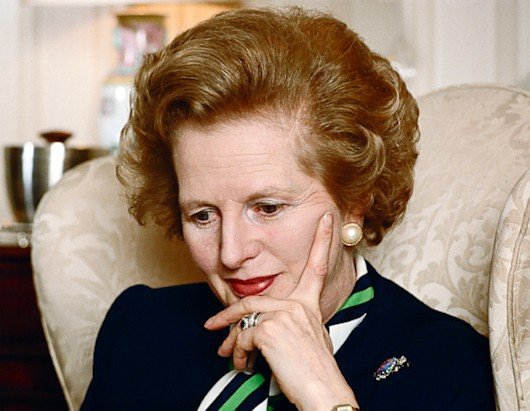
Margaret Thatcher’s funeral will take place on Wednesday, April 17
Margaret Thatcher will not have a state funeral but will be accorded the same status as Princess Diana and the Queen Mother.
A ceremonial funeral is one rung down from a state funeral – normally reserved for monarchs – and requires the consent of the Queen.
A Downing Street spokesman said the details had been agreed at a “co-ordination meeting” between the Thatcher family and Buckingham Palace on Tuesday morning.
Baroness Thatcher, a Conservative, was Britain’s first female prime minister. She was in office from 1979 to 1990, winning three successive general elections.
She died “peacefully” after suffering a stroke while staying at the Ritz hotel in central London. Lady Thatcher had been staying at the hotel since being discharged from hospital at the end of last year.
An undertaker’s van carrying a silver casket left the hotel early on Tuesday morning for an undisclosed location.
Parliament will be recalled from its Easter recess this Wednesday to enable MPs and peers to pay tributes.
But Labour MP John Mann said: “I do not know why we are wasting taxpayers’ money on an additional session.
“It is perfectly valid that, when a prime minister dies, MPs can pay tribute, but this could be perfectly properly done on Monday.”
PM David Cameron has described Margaret Thatcher as a “great Briton” and international leaders, including US President Barack Obama and German Chancellor Angela Merkel have praised her.
Lady Thatcher was born Margaret Hilda Roberts, the daughter of a shopkeeper and Conservative councilor in Grantham, Lincolnshire, in 1925. She became an MP in 1959.
Having been education secretary, Margaret Thatcher successfully challenged former PM Edward Heath for her party’s leadership in 1975 and won general elections in 1979, 1983 and 1987.
Margaret Thatcher resigned as prime minister in 1990 and had been in poor health for several years prior to her death.
[youtube VZoE5sVhv5A]
Queen Elizabeth II is often said to have had a less than easy relationship with former premier Margaret Thatcher, her eighth – and longest-serving – prime minister.
Born six months apart, Margaret Thatcher and the Queen were two women very much making their mark in a man’s world.
Always mindful of her constitutional role and cordial to the last, the British monarch is nevertheless said to have personally disagreed with some of Margaret Thatcher’s more divisive policies and privately expressed her alarm over issues such as unemployment and the miners’ strike.
A Buckingham Palace spokesman issued a statement on Monday saying the Queen was “sad to hear the news of the death of Baroness Thatcher” and would be sending a private message of sympathy to her family.

Born six months apart, Margaret Thatcher and the Queen were two women very much making their mark in a man’s world
However, there was no confirmation that the Queen would attend the funeral (as she did for Sir Winston Churchill, although that was a state occasion), despite having no public engagements in her diary for either Wednesday or Thursday next week.
Instead, a spokesman said the Queen was “waiting for details about the funeral arrangements from the Government”. While Her Majesty may have found her first female prime minister somewhat frosty, Lady Thatcher’s respect and admiration for the monarch knew no bounds, not least because she had been raised in an intensely patriotic family.
Margaret Thatcher once told author Gyles Brandreth that the talk of a strained relationship with the Queen was “a lot of nonsense” and spoke with admiration about her commitment to the Commonwealth and armed services.
“No one could curtsey lower than Margaret Thatcher,” said another former aide.
Inevitably, after 11 years of almost weekly meetings, the Queen and Margaret Thatcher reached something akin to friendship.
Margaret Thatcher was even said to have jokingly sent the monarch a pair of rubber gloves as a Christmas present after witnessing her doing the washing up following a barbecue at Balmoral without a pair. Other sources say it wasn’t that the two women did not like each other, they were simply very different people.
The Queen is dry and rather witty in private, while Margaret Thatcher always had a tendency to hector, regardless of her audience.
In 1986, their relationship was put under the spotlight when The Sunday Times reported sources close to the Queen saying she was “dismayed” by “uncaring” Margaret Thatcher’s refusal to impose sanctions on apartheid South Africa, a decision the monarch feared would split the Commonwealth.
The story caused uproar. The Queen is required constitutionally to keep her opinions private. The quotes were subsequently attributed to the Palace’s press secretary, Michael Shea. The monarch is said to have rung Margaret Thatcher to reassure her that her views were nothing of the sort.
If the relationship was never entirely easy, the two certainly never wavered in their mutual respect. The Queen, in particular, is said to have admired Margaret Thatcher’s grit, determination and enormous achievements.
After Margaret Thatcher’s enforced resignation in 1990, the Queen awarded the baroness the Order of Garter and the Order of Merit – neither of which has been offered to Tony Blair.
The Queen was also a guest of honor at Margaret Thatcher’s 80th birthday celebrations.
Fellow guests were touched at the sight of the Queen taking the hand of Margaret Thatcher as she gently raised her from a deep curtsey, before guiding the already frail baroness through the throng of assembled guests.
Former British PM Margaret Thatcher will be given a ceremonial funeral with full military honors at St. Paul’s Cathedral in London.
Margaret Thatcher’s funeral service is expected to take place next week, and will be similar in status to those accorded to the Queen Mother and Princess Diana.
Many members of Parliament have called for Iron Lady to be given a state funeral, as was given to former Prime Minister Winston Churchill, but that was against her own wishes.
Margaret Thatcher’s spokesman and friend, Lord Bell, has said that Britain’s first female PM “specially did not want state funeral, and nor did her family”.
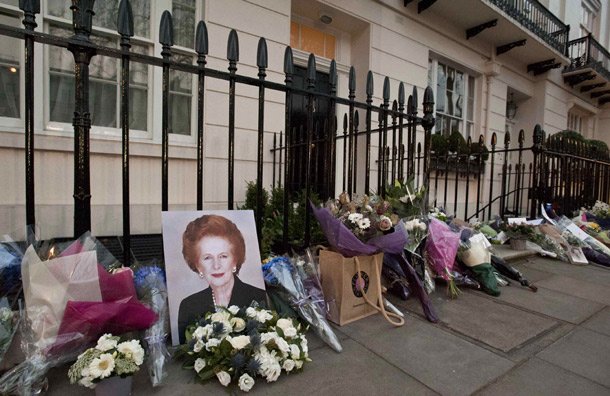
Margaret Thatcher’s funeral service is expected to take place next week, and will be similar in status to those accorded to the Queen Mother and Princess Diana
“She particularly did not wish to lie in state as she thought that was not appropriate,” Lord Bell said.
“And she did not want a fly-past as she thought that was a waste of money – somewhat in character you might think.”
Details of the ceremonial funeral with military honors are understood to have been mapped out in talks between government officials and Baroness Thatcher more than five years ago.
Former Soviet leader Mikhail Gorbachev and Nancy Reagan, wife of her closest ally US President Ronald Reagan, are expected to lead a list of international mourners.
Margaret Thatcher did request a central role for The Chelsea Pensioners at her funeral. The Army veterans will not only welcome her coffin when it arrives at St Paul’s, but will also benefit from donations made in her memory – her family have requested that, instead of flowers.
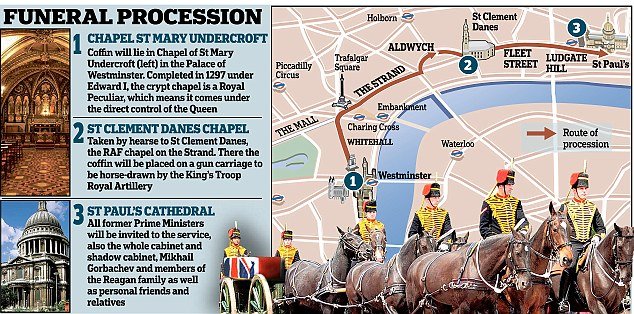
Margaret Thatcher funeral cortege route and procession details
The day before the funeral takes place, Margaret Thatcher’s coffin will be moved to the chapel of St Mary Undercroft in the Palace of Westminster. There will be a short service following its arrival and the coffin will rest there overnight.
The following day, the streets will be cleared before the coffin travels by hearse to the Church of St Clement Danes, the central church for the RAF, on the Strand. There it will be transferred to a gun carriage drawn by horses of the King’s Troop of the Royal Artillery, the Queen’s ceremonial Saluting Battery.
Lady Thatcher’s funeral cortege will pass through Whitehall, Trafalgar Square and along the Strand, round Aldwych and then up Ludgate Hill to St Paul’s. Serving members of all three Armed Forces will line the route, alongside an expected crowd of tens of thousands of people.
At the steps of St Paul’s, the coffin will be met by another Guard of Honour and the Chelsea Pensioners. Members of the three services will then bear the coffin into St Paul’s for the funeral service.
As well as friends and family of Margaret Thatcher, politicians who served in her cabinet are expected to attend the service alongside current cabinet members. It is not yet known whether the Queen will be attending.
After the service, there will be a private cremation service in Mortlake, south-west London. It is understood that Margaret Thatcher wished to be laid to rest alongside her husband, Denis, who died in 2003, in the cemetery of the Royal Hospital Chelsea.
[youtube Upd-aq71eE8]
[youtube AALPZqWThmo]
A guide to the extraordinary life and career of the first British female prime minister, Margaret Thatcher:
Who was Margaret Thatcher?
Margaret Thatcher, born Margaret Hilda Roberts in Grantham, Lincolnshire on 13 October 1925, was the longest-serving British prime minister in modern times and the first woman to lead a major Western democracy. She won three successive general elections and spent a total of 11 years in Downing Street, from May 1979 to November 1990.
What did Baroness Thatcher achieve?
British society changed almost beyond recognition during the Thatcher years, as heavy industry closed and a new free market economy was born. The political philosophy she established still dominates British politics to this day. But critics say the changes came at the price of a more divided society and the destruction of traditional working-class communities.
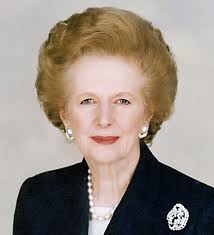
Margaret Thatcher was the longest-serving British prime minister in modern times and the first woman to lead a major Western democracy
What about on the international stage?
Margaret Thatcher joined forces with US president Ronald Reagan to pioneer a new form of dynamic free-market conservatism, which has since taken root around the world. Her support for reforming Soviet president Mikhail Gorbachev arguably hastened the end of the Cold War and the spread of democracy to former Eastern Bloc states.
What was Margaret Thatcher’s background?
The younger of two daughters, Margaret Hilda Roberts was born in 1925 in Grantham, a small market town in eastern England. Her father, Alfred, owned a grocer’s shop and was involved in local politics. She went to an all-girls grammar school, before studying chemistry at Oxford University. She then trained as a barrister, specializing in tax. She married divorced millionaire businessman Denis Thatcher and had two children – twins Carol and Mark.
How did Lady Thatcher get into politics?
She owed her lifelong passion for politics to father Alfred, who was on the local council in Grantham. At Oxford in the mid 1940s, she became the first female president of the university’s Conservative association. In 1959, at the age of 34, she was elected as an MP, for the north London seat of Finchley, in an era when female politicians were still a rarity.
How did Margaret Thatcher become prime minister?
Margaret Thatcher had a rough ride after Tory leader Ted Heath made her education secretary in 1970. She was dubbed “Thatcher the milk snatcher” after her decision to end free school milk for older primary school pupils. The prospect of her becoming party leader, let alone prime minister, seemed a distant one. But after the Tories lost the second 1974 general election there was a hunger in the party for a different approach and to the surprise of many, herself included, she defeated Ted Heath in a 1975 leadership election. Four years later she was elected prime minister with a Commons majority of 43.
What were the key moments of her early years in power?
Margaret Thatcher was determined to revive Britain’s ailing economy but her choice of medicine – squeezing inflation and clamping down on public spending and borrowing – led to a far worse downturn than most had predicted. Unemployment soared above three million as large chunks of Britain’s manufacturing and heavy industries closed down. England’s inner cities saw riots in 1981. Her refusal to do a U-turn – as her predecessor Ted Heath had done – meant she appeared to be heading for defeat at the next election. The Falklands War – when she sent a naval task force to retake the South Atlantic islands invaded by Argentina – and Labour’s leftward lurch are both credited with helping her win that second election.
What about Margaret Thatcher’s second term?
Margaret Thatcher was re-elected by a landslide in 1983, in a wave of post-Falklands patriotic fervour. But her second term saw more turmoil – including one of the longest and most bitter industrial disputes in British history in the 1984 miners’ strike. In October of that year, with the strike still under way, the IRA attempted to murder Margaret Thatcher and her cabinet by bombing her hotel during the Conservative Party conference in Brighton. The economy improved towards the end of her second term as free market reforms and the sale of state assets gathered pace.
What about her third term?
A second landslide followed in the 1987 general election, with Margaret Thatcher returning to Downing Street with a 102 seat majority, becoming the longest continually serving prime minister since Lord Liverpool in the early 19th Century. Her third term was marked by an increasingly hard line on Europe, and the continuation of economic reforms with privatization and the further growth of home and share ownership.
How did Margaret Thatcher’s premiership come to an end?
In one of the most dramatic episodes in political history, Margaret Thatcher was ejected by her own MPs three years after her 1987 election victory amid public anger over a new tax system for local government, dubbed the poll tax. The resignation of ultra-loyal Foreign Secretary Geoffrey Howe, over her increasingly skeptical stance on Europe, finally triggered her downfall after senior Conservatives told her she would lose a leadership election. She never lost an election.
What were Margaret Thatcher’s key domestic reforms?
Seeking to tame inflation through monetarist economic policy, curbing union power, selling off nationally owned monopolies, liberalizing the stock market and introducing the right-to-buy for council tenants.
What is Margaret Thatcher’s legacy?
Britain would probably be a very different place today without Margaret Thatcher. Her bold free market reforms and curbs on union power – that caused so much controversy in the 1980s – are now accepted as conventional wisdom by all mainstream British political parties. The centre ground of British politics shifted to the right as a result of her time in power.
Margaret Thatcher is, furthermore, a global icon and role model for female politicians and, with Ronald Reagan, one of the towering figures of the political right.
She suffered from poor health for several years before her death.On 21 December 2012, she underwent an operation to remove a growth from her bladder.
Margaret Thatcher died on 8 April 2013 in London following a massive stroke. Her spokesman, Lord Bell, confirmed her death at 12:52 BST (11:52 UTC) by press release.
[youtube q0Q_AsonCK0]
Seven outfits worn by Margaret Thatcher during the 1970s in the early part of her career are being auctioned at Christie’s on Monday.
They form part of its London Sale, which is being held to celebrate the Queen’s Diamond Jubilee and London 2012.
Sold by a private collector, the suits which come in an array of colors, are thought to be the first of Lady Thatcher’s clothes to be sold at a public auction.
All of the Iron Lady’s outfits have been given a guide price of between £1,000 ($1,600) and £1,500 ($2,500).
Pat Frost, Head of the Textiles Department at Christie’s told the BBC: “These outfits were worn at the beginning of her career, when she got the <<milk snatcher>> tag, and were part of important moments like her introduction as leader at the Conservative Party conference.”
She said she was not aware of any previous auctions of Lady Thatcher’s outfits.
Last year Lady Thatcher’s black Asprey rectangular leather handbag sold for £25,000 ($39,000) at auction.
She was said to deploy it to enforce cabinet solidarity.
The term “handbagging” was used as a reference to the way she disciplined unrurly Tory backbenchers and ministers during her years in Downing Street.
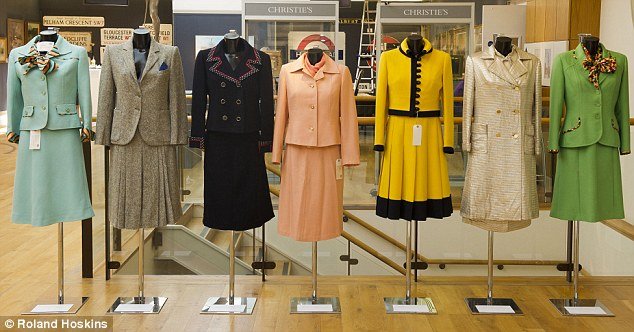
Seven outfits worn by Margaret Thatcher during the 1970s in the early part of her career are being auctioned at Christie's on Monday
Canary yellow dress
This was worn to the Conservative Party conference in 1975 and Lady Thatcher can be seen wearing it in contemporary news footage, standing alongside Edward Heath on the conference platform.
Navy dress
Margaret Thatcher can be seen in the navy suit during a Valerie Singleton programme.
Peach wool suit
This outfit she wore while being grilled about moisturiser by Sue MacGregor in 1971.
Light green suit
This was worn when she was confirmed as the new leader of the Conservative Party .
Navy suit
Margaret Thatcher is seen wearing the navy suit in an episode of Val Meets the VIPs, which was presented by Valerie Singleton.
Green suit
Margaret Thatcher wore the green suit in a 1972 edition of Panorama called Women in Politics.












